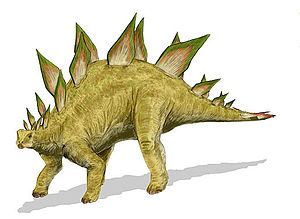Wikijunior:Dinosaurs/Stegosaurus

Stegosaurus is Greek for "plated lizard"; this name is given to the dinosaur due to a heavy armour of plates down its back. It is also sometimes known as one of the dumbest dinosaurs, because it had a very small brain compared to its large body.
What did they look like?[edit | edit source]
| Dinosaurs |
|
Tyrannosaurus Rex |
An average Stegosaurus was about 12 m (40 ft) long and about 2.75 m (9 ft) tall. Stegosaurus weighed about 2,000 kg or 6,800 pounds (around 2 tons!) Stegosaurus's front feet each had five toes and there were three toes on each back foot. The feet resembled gigantic horse hoofs and the people who first discovered them actually thought they might have come from giant horses!

The most prominent feature of a Stegosaurus was the row of plates running down its back, along the spine. These plates could be larger than 75 cm in height! It was once thought that they were used as protection against predators such as the Allosaurus, but in fact they were not solid bone and would have been easy to break. They were covered with thin skin and lots of blood vessels.
Nobody knows for sure what the back plates were used for, but many scientists now believe that they were used for temperature control – to gather heat from the surroundings. They would have been used like solar panels. When the animal needed to warm up, it would stand with its side toward the sun. The thin skin and many blood vessels covering the plates would soak up the heat of the sun. When the Stegosaurus got too hot, it could stand in the shade, or turn itself to face the sun (or face away from it). Then the blood vessels could be cooled. Another theory is that the plates could "blush", filling up with blood; the now-red plates could be used to attract a mate, or scare enemies.
For defence Stegosaurus did have four (or eight) heavy spikes on its tail, which could be used to hit attackers.
Stegosaurus's mouth was shaped a bit like a beak and had no teeth in the front – probably for snipping plants.
What did they eat?[edit | edit source]
Stegosaurus was a herbivore, meaning it ate plants. It mainly liked to browse plants near the ground, because they were the easiest to reach with its short neck. They were plants such as ferns, mosses, cycads and baby evergreen trees, which contained little nutrition. Most of them were only 3–4 feet high. Stegosaurus may have been able to rear up on its hind legs for short periods of time to browse plants that were otherwise out of reach.
Due to plants having little nutrition in each bite, the Stegosaurus had to eat a lot. It would spend most of its day eating.
When did they live?[edit | edit source]
They lived during the late Jurassic period about 156–145 million years ago.
Where did they live?[edit | edit source]
They lived in subtropical parts in the USA, but there were also stegosaurus living in other parts of the world including Africa, China, Mongolia and Europe.
Stegosaurus fossils have been found in the US states of Colorado, Utah and Wyoming.
How were they discovered?[edit | edit source]
The first Stegosaurus fossil was found in Colorado, USA, in 1876 by M. P. Felch. It was named in 1877 by Othniel C. Marsh.
The most complete Stegosaurus fossil ever found was nicknamed "Spike". It was discovered in Colorado, USA, by Bryan Small, Tim Seeber and Kenneth Carpenter in 1992.
What do we need to learn?[edit | edit source]
- We would like to know why "Stegosaurus" had the big bony plates on its back. Did they cool Stegosaurus? Did it use them to show off? Or to protect itself? We don't know.
- Stegosaurus's back plates were not solid – they were filled with long hollow tubes or tunnels. What were they for?
- Stegosaurus had cousins, known as Stegosaurs. Some of the cousins lived in herds (like cows and horses do today), and some did not. We would like to know whether Stegosaurus lived in herds, or whether it lived mostly alone.
- Stegosaurus had a very small brain. Scientists used to think a structure near its hip was a second brain, perhaps to help control its tail and hind legs. Now they think it might be a "glycogen body", which is something birds have and is related to storing energy, although they're not sure quite what it does even in birds. We would like to know for sure.